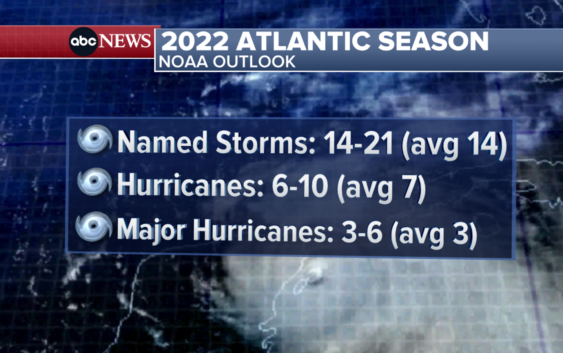- Artists transform hurricane aftermath into hoop-inspired masterpieces at Charlotte exhibit
- NC's cost for Hurricane Helene damage is nearly $60 billion, state says
- State to develop drone program to better respond to disasters like Helene, Florence
- South Carolina residents face deadline to get storm debris out to the curb after Hurricane Helene
- SCDOT to pick up Hurricane Helene debris for a final day in South Carolina
NOAA predicts above average Atlantic hurricane season, releases storm names

The NOAA’s 2022 Atlantic Hurricane Season Outlook predicts 14 to 21 named storms, meaning winds 39 mph or higher, with 14 being the average.
“NOAA is predicting an above normal 2022 Atlantic hurricane season, which would make this year the seventh consecutive above normal season,” NOAA Administrator Dr. Rick Spinrad said. “Specifically, there’s a 65% chance of an above normal season, a 25% chance of a near normal season, and just a 10% chance of a below normal season.”
It includes six to 10 hurricanes, meaning winds 74 mph or higher (the average is seven) and three to six major hurricanes, category 3/4/5 with winds 111 mph or higher (average is three).
The NOAA also released storm names for the upcoming hurricane season, as needed.
They are: Alex, Bonnie, Colin, Danielle, Earl, Fiona, Gaston, Hermine, Ian, Julia, Karl, Lisa, Martin, Nicole, Owen, Paula, Richard, Shary, Tobias, Virginie, Walter
“We just experienced two extremely active hurricane seasons, marking the first time on record that two consecutive hurricane seasons exhausted the list of 21 store names,” Dr. Spinrad said. “If you go back two years to 2020 hurricane season, broke records across the board and it’s the most active season on record with 30 named storms. The 2021 hurricane season, which is the third most active year on record in terms of names of storms, brought us 21 named storms with impacts ranging from the Appalachian Mountains all the way to New England, resulting in over $78 billion of damage. One of those storms, Hurricane Ida, of course made a huge impact right here in New York City, hundreds of miles north from where it made landfall.”
Experts say the reasons for the active hurricane season include:
–Ongoing La Nina conditions that will persist through summer and into early fall.
–Warmer than normal Atlantic sea surface temperature.
–Weaker Tropical Atlantic Trade Winds
–An enhanced African Monsoon, that feeds the strongest and longest hurricanes.
“Hurricane Ida spanned nine states, demonstrating that anyone can be in the direct path of a hurricane and in danger from the remnants of a storm system,” FEMA Administrator Deanne Criswell said. “It’s important for everyone to understand their risk and take proactive steps to get ready now by visiting Ready.gov and Listo.gov for preparedness tips, and by downloading the FEMA App to make sure you are receiving emergency alerts in real-time.”
The way in which climate impacts hurricanes is still an area of study for NOAA scientists. In the past several years, storms have rapidly intensified before landfall, fueled by above normal sea surface temps.
In the last several decades, because of the growth of urban settings, there have been more extremes like record flooding in never-before seen areas.
NOAA’s outlook is for overall seasonal activity and is not a landfall forecast.
Hurricane season runs from June 1 through November 30.
Copyright © 2022 WTVD-TV. All Rights Reserved.